7 January 09: The Possible City
Slow Moving, City Alive
Slow, Moving City, Alive
Slow Moving City, Alive
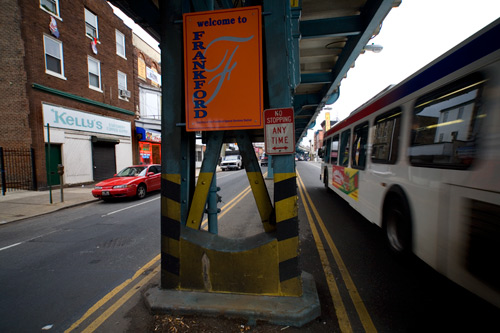 by Nathaniel Popkin January 7, 2009 One day, three weeks ago, this website's publisher, Brad Maule, and I stood on a third floor balcony of the modern (1928) section of the Globe Dye Works, in Frankford. The balcony faces Worth Street, a road that being parallel to train tracks, feels as if it is at the edge of a small town, and out past a scrap yard, the R7/Amtrak rail line, and the Aramingo interchange of I-95. It's a linear, aluminous landscape punctured now and again by smokestacks and water towers and draped by the dull white noise of the highway. The Betsy Ross Bridge hangs low in the distance. In the immediate foreground, on Worth Street, stand a set of plain, squat twin houses, some with awnings on the windows, some with original decorative woodwork along the A-frame roof line. 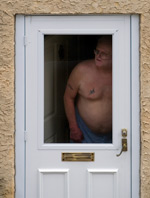 As we stood there observing this landscape that feels at once immense and also mutable, I noticed a shirtless man standing in the doorway of one of the
houses, his torso framed by the opening of the screen door. The day was finely gray and chilly; there had been snowflakes earlier in the morning and so, at
once, I had the feeling of an overheated room, and of silence, loneliness, a swelling sadness. The picture of a person gazing out a window -- separate,
hidden, and unsure -- might be relied on to deliver melancholy, but the scene before us -- brick houses, the rails, a spray of bare trees -- had the
particular zeitgeist of a calloused mill town, of truncated, and provincial, Pennsylvania. (Just an hour before, as Brad and I walked along Tackawanna
Street, he was reminded of his hometown, Tyrone, in the hills of Central PA.)
As we stood there observing this landscape that feels at once immense and also mutable, I noticed a shirtless man standing in the doorway of one of the
houses, his torso framed by the opening of the screen door. The day was finely gray and chilly; there had been snowflakes earlier in the morning and so, at
once, I had the feeling of an overheated room, and of silence, loneliness, a swelling sadness. The picture of a person gazing out a window -- separate,
hidden, and unsure -- might be relied on to deliver melancholy, but the scene before us -- brick houses, the rails, a spray of bare trees -- had the
particular zeitgeist of a calloused mill town, of truncated, and provincial, Pennsylvania. (Just an hour before, as Brad and I walked along Tackawanna
Street, he was reminded of his hometown, Tyrone, in the hills of Central PA.) Perhaps it was our perch -- on the balcony of a factory being transformed into a "creative compound" -- that gave me the feeling of eyeing a place left behind. The quiet reclamation going on inside the labyrinthine mill, one of the longest operating textile mills in Philadelphia (having survived until 2005), comes with some of highest and most finely-tuned expectations of the contemporary city. When completely adapted, it's a complex that will support the production and celebration of art and craft industry, an unpretentious savoring of evocative industrial remains. "Move here and prosper," summons the sales brochure, as if to mock Frankford's fortunes this last half century of urban decline. 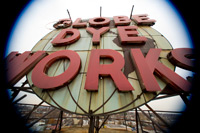 One of the things that's interesting about the adaptive reuse of the Globe Dye Works, whose iconic mid-century sign beckons auto and rail travelers along
the northeast corridor, is the expectation of its developers, a team of Charlie Abdo, brothers Matt and Ian Pappajohn, and Pete Kelly. They're pitching the
project not just to Philadelphia artists and craftsmen, but to creative people everywhere. And indeed, according to Abdo, half of the tenant inquiries are
coming from Brooklyn. Matt Pappajohn backs up the claim.
One of the things that's interesting about the adaptive reuse of the Globe Dye Works, whose iconic mid-century sign beckons auto and rail travelers along
the northeast corridor, is the expectation of its developers, a team of Charlie Abdo, brothers Matt and Ian Pappajohn, and Pete Kelly. They're pitching the
project not just to Philadelphia artists and craftsmen, but to creative people everywhere. And indeed, according to Abdo, half of the tenant inquiries are
coming from Brooklyn. Matt Pappajohn backs up the claim. The Pappajohns, professional cabinetmakers since 1996, moved their shop from Kensington into the former Henry Riehl loom factory on Orchard Street in Frankford in 2003. In that compound, which includes a renovated 18th century mill used as live-work space, are entrepreneurially-minded artists and designers from Rhode Island, New York, and Los Angeles. "Frankford hasn't been a challenge," says Matt Pappajohn, who speaks with an unusual combination of thoughtfulness, sincerity, and blunt intensity, "it's been great for us. If you squint your eyes, it's like 1950s America. Just ignore the pushers." A mill town dating to the late 17th century, Frankford grew slowly for its first century and a half. Of Philadelphia's satellites -- those adjacent towns and cities that would in 1854 consolidate into one Philadelphia -- Frankford was always to be the least economically robust. Unlike Spring Garden or Southwark or the Northern Liberties, it was never one of the new nation's largest cities. In fact, it didn't grow significantly until the 1850s, and by then it was no longer an independent town. But, as Philadelphia became the nation's largest and most diversified textile manufacturer, Frankford firms seized water power -- Globe Dye was fueled by the Little Tacony Creek, buried to create Torresdale Avenue -- to produce yarns, woolens, calico prints, and carpets, among other industrial products. 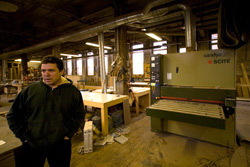 Unsquint your eyes and the Frankford that appears probably won't meet your preconception. "It's really old, which we didn't realize [before we came]," says
Pappajohn, noting the 1781 Quaker meetinghouse outside the window of his Orchard Street Mill. "I thought it was the end of the world," reveals the reticent
and soft spoken Abdo, who moved to Philadelphia in the late 1960s from Brooklyn, and who ever since has been renovating buildings in the Northern Liberties,
Fairmount, and Kensington. "Now I've had a whole kind of change of attitude."
Unsquint your eyes and the Frankford that appears probably won't meet your preconception. "It's really old, which we didn't realize [before we came]," says
Pappajohn, noting the 1781 Quaker meetinghouse outside the window of his Orchard Street Mill. "I thought it was the end of the world," reveals the reticent
and soft spoken Abdo, who moved to Philadelphia in the late 1960s from Brooklyn, and who ever since has been renovating buildings in the Northern Liberties,
Fairmount, and Kensington. "Now I've had a whole kind of change of attitude."This Frankford -- the remains of small mills and workshops, two and three-storey rowhouses made of stone and stucco with little porches and gardens, and tiny Victorians right out of Tom and Jerry and church bells and December cherry blossoms, hand-painted signs, black Santas, and long, heavy beams and iron doors and towering maple trees, work aprons and tools, and streets named Cloud, Unity, Pear -- so well served by the El, and so diverse, calls out. This Frankford feels not harsh, but inviting, not failed and miserable and lonely, but rather like a quiet charm. Squint and unsquint again and the picture clouds. At about 34,000 people, Frankford's population has held steady for 20 years. But residents here are poorer than even the city average, and rates of education are pitifully low. More than a quarter of adults have no high school degree; fewer than one in ten have completed college. There were 13 homicides in the neighborhood last year, up slightly from 2007. There are pushers and prostitutes; there is hell and desperation. You can feel it while standing in line for a slice of pizza at Leandro's, or walking down Church Street past a forty-something woman with hallow cheeks, a 16 year old with a muted face, a cigarette, and a stroller, or turning onto Tackawanna mid-morning to the sound of yelping dogs and two warrant officers pounding on a door. Jim McCarthy, who has renovated dozens of neighborhood properties, including live-work spaces for artists and musicians, and whose wife, Joan Oliveto, opened and then closed a New Orleans-style restaurant, Mosaic, at Frankford Avenue and Gillingham Street, in 2007, says that sometimes at night "it's a little scary." Gilbert Pons is a slim, neatly dressed man in his forties. Along with his brother Ricardo, he owns Gilbert's Upholstery on Frankford Avenue. Inside the Pons' workshop, a team of four employees refinishes and reupholsters furniture, with a particular eye for what's considered "mid-century modern," elegant, low slung smooth wooden chairs, tables, and cabinets. Gilbert Pons admits the neighborhood feels "stagnant." This was not his hope a few years ago, when his highly calibrated antique shop was joined by other dealers, a specialist in lampshades, a café, an art galley named Revival. Pons sits in the warmly painted showroom filled with futuristic furniture of the 1950s and 60s -- a Styrofoam chair, a sky blue '59 recliner, the "Niagra" -- and waits. "I think it will get better," he laments. * * *  The Frankford Elevated, completed in 1922 and rebuilt in the 1980s and 90s, is the neighborhood's curving spine. It, and the Avenue itself, the neighborhood's primary shopping street, are in part what give this neighborhood such good "bones," and the hope for a more urbane and prosperous future. Sit in the Pons' showroom, and there, right above, is the El; stand looking out the restored factory windows of what will be a painter's studio at Globe Dye, and there's the El; play Frisbee in Womrath Park and the El rises above, a flash of speed and efficiency that connects Frankford to Kensington, Fishtown, Northern Liberties, Center City, and on to West Philly. "The El is our friend," says Pappajohn, who also serves on the Board of the Fishtown Neighbors Association, "15 minutes to 5th and Market." In 2006, then interim City Councilman Dan Savage established a Special Services District along Frankford Avenue, an entity that wasn't favored by some businesses along the Avenue (its funding comes from a relatively small, special surcharge levied on building owners) and which was slow in getting started. Also that year, the City Planning Commission completed a plan by the firm Wallace Roberts and Todd, which called for an emphasis on high-density mixed-use nodes at each of the three neighborhood El stations, Church, Margaret-Orthodox, and the Frankford Transportation Center. The plan, really not much more than a generic urban design template, followed the much more rigorous and community focused Frankford Plan of the mid-1990s. "It's been planned out," comments the present Frankford Councilwoman, Maria Quiñones-Sánchez, whose large 7th district covers much of the Barrio and the river wards. "What we don't get is a plan of action." But Quiñones-Sánchez, who speaks with a mixture of warmth and urgency, is worried that the Frankford leaders lack the capacity to implement changes. "We can move this forward, but I'm not going to spin my wheels," she says. So she's giving the Special Services District and the Frankford Community Development Corporation, two entities who in the recent past have had difficulty working together (a matter of longstanding personal differences, according to Quiñones-Sánchez), additional time to build consensus and institutional capacity. "It's a lot more difficult than just talking together." 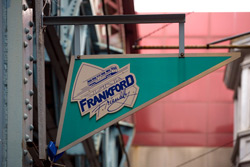 Like many inside the administration of Mayor Michael Nutter and several of those on City Council, Quiñones-Sánchez is reconsidering the
effectiveness of a community development program that's rigidly neighborhood-focused. Pure bottom-up planning and local control hasn't stemmed urban
decline; instead it's led to fragmented community development and inefficiency. At worst, it puts taxpayer money in the hands of those ill-equipped to
manage redevelopment and the provision of social services. Top-down planning has the advantage of rational decision-making. "I want to deal with data,"
notes Quiñones-Sánchez.
Like many inside the administration of Mayor Michael Nutter and several of those on City Council, Quiñones-Sánchez is reconsidering the
effectiveness of a community development program that's rigidly neighborhood-focused. Pure bottom-up planning and local control hasn't stemmed urban
decline; instead it's led to fragmented community development and inefficiency. At worst, it puts taxpayer money in the hands of those ill-equipped to
manage redevelopment and the provision of social services. Top-down planning has the advantage of rational decision-making. "I want to deal with data,"
notes Quiñones-Sánchez. She'd like to imagine, therefore, that she can put into place a district-wide or even city-wide plan to clean and manage primary retail streets, to coordinate capital improvements, to build new housing that responds to a global aspiration for the city's future. But as we've seen Mayor Nutter struggle recently to eliminate 11 library branches without neighborhood consultation, a top-down approach may be simply inconsistent with the broad and intransient power of ward and neighborhood-based politics. It also risks alienating those who work the hardest to improve the city. "Some of the most talented work under the radar," explains Quiñones-Sánchez. That's why she hopes to compel Frankford's four leading community-based organizations -- the SSD and CDC as well as the Civic Association and the Frankford Business and Professional Association -- to come together under a shared agenda. If that doesn't work, she tells me, "Guys, new rules." The developer Jim McCarthy, whose brother Jack heads up the Frankford Historical Society, has been renovating buildings in Frankford for a half-dozen years or so. He's a lanky fifty-something with an easy-going, fair, and honest manner. He was one of the first these last two decades to start purchasing and fixing-up properties along the Avenue. This year, after his wife's restaurant closed, he's been instrumental in resurrecting the Special Services District, which installed bright blue trash receptacles and concrete planters below the El. He also hired a new cleaning service. The result of all of this is a retail district -- one of the longest and most vital neighborhood shopping streets in Philadelphia -- that's cleaner and less grim than it has been in recent memory (the lack of pedestrian lighting notwithstanding). The Councilwoman notes rightly that "a clean corridor is just a first step." It's also one that's been hard to achieve -- and not only because of a lack of neighborhood capacity or judgment but also because of shortcomings of City Hall. If a new balance between top-down and bottom-up planning is to be rectified, then City Hall is going to have to make it easier for small builders, developers, and community activists to make improvements in their neighborhoods. 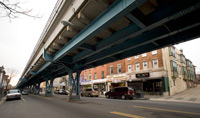 I raise this possibility with McCarthy as I watch him work inside one of the live-work spaces he carved from an old factory on Gillingham Street. He's
reconverted the space as an extension of Frankford Friends School. Having outgrown its campus, the school has temporarily shifted middle school classrooms
here. But because the space is used as a school, McCarthy has been required to make numerous changes -- like heating the vestibule -- some which seem
rational, some which appear designed to drive him crazy. An inspector from the department of Licenses and Inspections has already made several visits.
Each time he appears there's a new requirement.
I raise this possibility with McCarthy as I watch him work inside one of the live-work spaces he carved from an old factory on Gillingham Street. He's
reconverted the space as an extension of Frankford Friends School. Having outgrown its campus, the school has temporarily shifted middle school classrooms
here. But because the space is used as a school, McCarthy has been required to make numerous changes -- like heating the vestibule -- some which seem
rational, some which appear designed to drive him crazy. An inspector from the department of Licenses and Inspections has already made several visits.
Each time he appears there's a new requirement. But aren't these kinds of things improving? Wasn't that one of the promises of a Nutter administration? McCarthy, who is trying to get a fire-safe door to close properly, looks up and smiles. He sighs. "No, things are better," he says. Permitting is easier, service in the basement of the Municipal Services Building is friendlier. "They even have chocolate at the desk . . . and it's good chocolate!" Then McCarthy pauses. "Remember the Army-Navy across the street?" He's referring to a two-storey corner retail building with a lovely curved wall and the feel of 1933. McCarthy walked me through the building, the "Roxy," a few years before. Then it was filled with junk. Walls and floors had caved in. In the meantime, he'd invested about $150,000 into the Roxy, with the hopes of turning it into a café. He'd rebuilt the walls and replaced the joists to form the second floor when the L&I inspector made his expected visit. "'Are your joists wrapped in plastic?', he asked me," recounted McCarthy. "'No, my joists aren't wrapped in plastic. I've been doing this for thirty years, I've never heard of wrapping your joists in plastic'." "'I have to shut you down. Your joists have to be wrapped in plastic.'" "I was out of my mind with anger," says McCarthy. That was it, and many months ago. The building sits empty. "No one has ever told me to wrap my joists in plastic . . . Later that same inspector came here. I said, 'You remember me?' He said, 'Oh yeah, you know I had just seen that rule in a book right before I came to inspect your property. I'd never known about it before.'" McCarthy puts down his tools. "I don't know the solution to this," he says and grimaces, and turns away. * * * It's a bright July day when I visit Diane Richardson at the far end of Frankford, on Bridge Street. Just the day before Amissi Ndukumassabo and Bintou Soumare, well-regarded immigrants from Mali and residents of Oxford Street not ten blocks away, were shot and killed in their store, Urban Wear, on Wyoming Avenue. The couple had worked their way up from owning a vendor cart on Front Street. 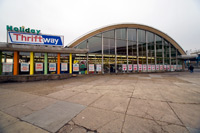 It's here at this end of Frankford, especially in the blocks around the Frankford Transportation Center, that one is reminded of the violence and
possibility of the neighborhood's urban potential. It isn't a mill town or a village; the busy El terminal amplifies the openness, as does the presence of
immigrants.
It's here at this end of Frankford, especially in the blocks around the Frankford Transportation Center, that one is reminded of the violence and
possibility of the neighborhood's urban potential. It isn't a mill town or a village; the busy El terminal amplifies the openness, as does the presence of
immigrants. The flip side of openness -- anyone's territory -- is that no one can control who enters. There are no walls, no monitors. As stark metaphor: an open field, a "dumping ground." This is just how some characterize Frankford, a victim of social service agencies, halfway houses, and drug treatment clinics that seek low rent and proximity to transportation. They're drawn to a void and their presence feels disproportionate. "It's a problem going on 30 years," says Councilwoman Quiñones-Sánchez, a matter of state policy and poor zoning. Gilbert Pons observes that "the huge number of ex-cons on the street is hard on the people who are trying to make money here." But some in Frankford are making money by catering to the less fortunate. It's a growth industry where there are otherwise few avenues for employment. "Well right now I am an entrepreneur, a successful entrepreneur in the inner-city," says Diane Richardson, a former practicing attorney who in 2002 founded an assisted living home for seniors, aged 50-62. Her clients, all men, are unable to live on their own. "I'm into my men," she says. 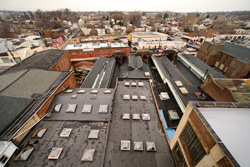 Richardson is a small woman in her fifties with an open face and a bright, incessant smile. Having grown up at 26th and Somerset in North Philadelphia, she
was the 1971 Simon Gratz senior class president. She attended Penn State University -- "polka-dot city." She says there were 3,300 white students and 700
African-Americans. "It was the best experience I could have."
Richardson is a small woman in her fifties with an open face and a bright, incessant smile. Having grown up at 26th and Somerset in North Philadelphia, she
was the 1971 Simon Gratz senior class president. She attended Penn State University -- "polka-dot city." She says there were 3,300 white students and 700
African-Americans. "It was the best experience I could have." As I meet with Richardson at the kitchen table of her 5-person, licensed care facility at Bridge and Mulberry, workers are finishing a 16-room addition in the adjacent lot. The house is clad in cream-colored vinyl, with green shutters, and wooden tulips along the fence. A garden connects the two buildings. Inside, residents are given home-cooked meals, provided health care, laundry, and taken out to go shopping. They live independently if they can. Richardson says because her staff is so well trained -- she offers training on site to employees -- she has a waiting list; the VA keeps calling. "And there's room to expand," she quips, relishing her own impact on the neighborhood. "This is someplace that could use some uplifting. To me, this was like Beirut." There were shootings, a drug house. But "I've come here to make it better, to clean up. The neighbors love me." "Where life is just beginning," is the Richardson Group's corporate motto. It strikes me as not all that dissimilar from the Globe Development Group's "Come here and prosper," strange, perhaps unexpected, signs of a city alive. I'm walking out of the Henry Riehl building with Matt and Ian Pappajohn when Matt wonders aloud if he and his partners are having an impact on Frankford. "Are we working in a vacuum?" He isn't waiting for a specific answer, but merely pondering. Then he speaks, a reminder. "It's never going to be Bella Vista, Society Hill, Fishtown. It's Frankford, that's good enough." –Nathaniel Popkin nathaniel.popkin@gmail.com For more on The Possible City, please see HERE. For Nathaniel Popkin archives, please see HERE, or visit his web site HERE. 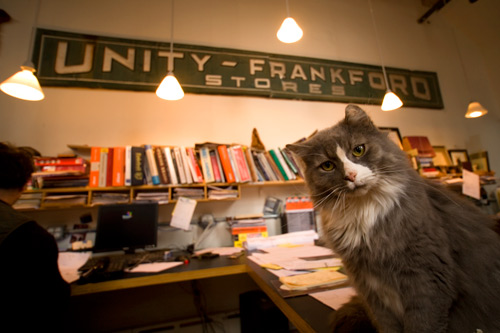 * * * There is now a companion set of photos to this essay, of Frankford neighborhood. It is HERE. |
|
• 20 November 08: Of weights and visions • 20 October 08: Dreams of a Magic City • 26 September 08: The opposite of decline • 19 September 08: "To see something greater" • 18 September 08: Dwindling/rekindling possibilities • 26 August 08: TPC, NOW AVAILABLE IN PAPERBACK • 26 June 08: The Mother of Invention • 29 Apr 08: "This is not pie-in-the-sky" • 1 Apr 08: Recess/Re-assess • 7 Mar 08: One-City Art Movement, Open to Everyone • 24 Feb 08: Too late for the streetscape? • 15 Feb 08: "It really could be something." • 18 Jan 08: Estuary of Dreams • 11 Jan 08: More than shelter • 10 Jan 08: Nature's balance • 6 Dec 07: Snake uprising • 4 Dec 07: A Junction that ought to be • 6 Nov 07: Around the Mulberry Tree we go • 29 Oct 07: Wondering about wandering • 5 Oct 07: No other way • 21 Sept 07: Here is the Possible City |
